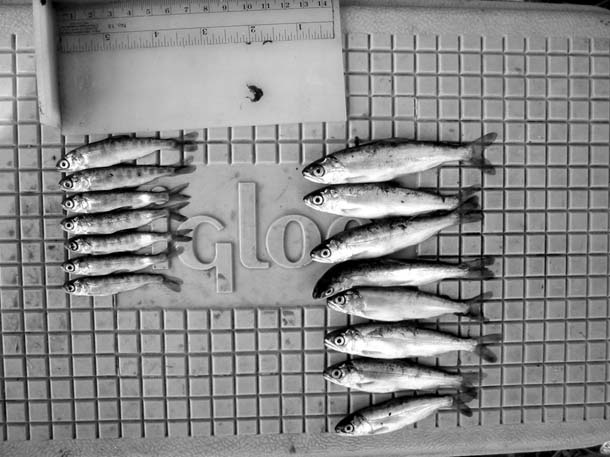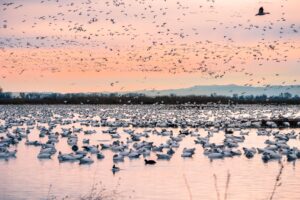Proponents of the Yolo Bypass Floodplain Fishery Enhancement Project are starting small but thinking big. During the first year of the pilot project, scientists will test whether raising juvenile chinook salmon on flooded rice fields in the Yolo Bypass will help the fish get stronger and bigger before being flushed down to San Francisco Bay and out to the Pacific. Researchers believe the five-acre test plot will show that a fallow rice field can provide the same protection and nourishment as a natural river floodplain, which no longer exists along the Sacramento River.
“It’s like a First Five for salmon,” says rice farmer John Brennan, referring to the statewide program aimed at early childhood development. Brennan, along with natural resource consultant David Katz, manages the salmon project. Marin-based Resource Renewal Institute‘s Huey Johnson, the initiator of the project, says the endeavor may represent the best hope for California’s struggling salmon population. Johnson cited a recent two-year study conducted by the UC Davis Center for Watershed Sciences that found that chinook salmon grow faster in a floodplain than in a river. “The bigger they are, the less likely they’ll be eaten when they reach the ocean,” says the center’s fisheries biologist Peter Moyle, perhaps the state’s foremost inland fishery expert.
-
The salmon on the right had access to a floodplain and grew substantially larger than the salmon on the left. Photo courtesy Carson Jeffres, UC Davis.
Built on the floodplain of the Sacramento River, the Yolo Bypass is an engineered system that has diverted flood-waters from the city of Sacramento and surrounding communities for nearly a century. During high flood events, the swelling river flows over a weir at the top of the bypass and onto a 40-mile-long, 57,000-acre collage of private farmland and public wildlife areas until it drains into the Sacramento-San Joaquin River Delta near Rio Vista. Today, any young fall- or winter-run salmon caught in the floodwaters either go for a fast ride out to the Bay or get stranded in the receding backwaters of the bypass when the flow stops.
This winter, land managers will pump water onto a winter-dormant rice field at Knaggs Ranch and then truck in several hundred juvenile fish to study the fish’s habitat preferences, looking for ideal water depths and bottom vegetation. Next year, they’ll provide a 10-acre floodplain nursery for more trucked-in fish. The ultimate goal is to provide up to 10,000 acres of winter floodplain habitat for chinook salmon and other native fish. The people behind the effort are gambling with several unknowns while jumping into the pilot project because of the potentially large payoff.
“I believe this is going to work,” says Johnson, who was also the first western regional director for the Nature Conservancy and founder of the Trust for Public Land. “If we discover that these little fish just need a nurturing environment, this could be a turning point for salmon recovery.”
Rice fields and floodplains also contribute to the mosaic of habitat needed by birds migrating on the Pacific Flyway. At the 16th annual San Francisco Bay Flyway Festival from February 10 to 12, 2012, on Mare Island in Vallejo, you can explore a rich diversity of habitat and learn about the migratory and resident birds that spend the winter in and around the wetlands of the North Bay. Check out the array of outdoor tours and indoor programs and exhibits at sfbayflywayfestival.com.

.jpg)


-235x300.jpg)